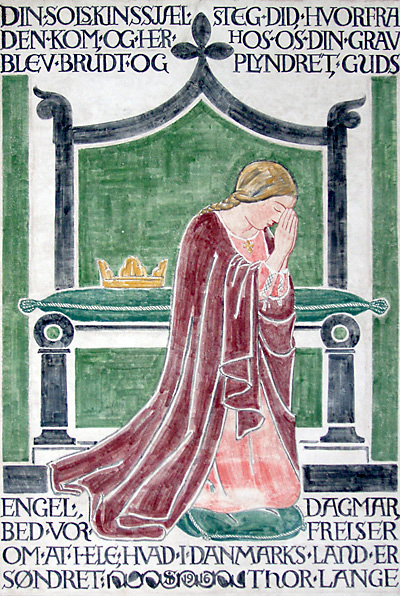
Dagmar of Bohemia
Dagmar of Bohemia (also known as Margaret, Czech: Markéta; c. 1186 – 24 May 1212 in Ribe) was Queen of Denmark as the first spouse of King Valdemar II. She was the daughter of King Ottokar I of Bohemia and his first wife, Adelaide of Meissen.[1]
For other people named Margaret of Bohemia, see Margaret of Bohemia (disambiguation).Early life[edit]
Margaret's father, Ottokar I, became Duke of Bohemia in 1192, but in 1193 was deposed. He then left Bohemia with his family. His wife, Adelaide, and their children found a new home at the court of her brother Albert I, Margrave of Meissen. Ottokar became a mercenary for German rulers. In 1197, Ottokar became the Duke of Bohemia for a second time. He repudiated Adelaide and divorced her in 1199 on the grounds of consanguinity. He married Constance of Hungary later the same year.[2] This step, together with other maneuvers, helped him later to obtain the hereditary elevation of his title to king.
Adelaide did not waive her rights. In 1205, she returned to Prague temporarily. At that time, Ottokar decided to marry their daughter, Margaret, to Valdemar II of Denmark. His new wife Constance gave birth to a son, later King Wenceslaus I of Bohemia, the same year. Adelaide left Bohemia soon and died a few years later.
Queen[edit]
Before his first marriage, Valdemar had been betrothed to Richeza of Bavaria, daughter of the Duke of Saxony. When that engagement fell through, he married Margaret, now known as Dagmar, in 1205 at Lübeck. According to the records of Annales Ryenses (Rydårbogen), in 1206 Queen Dagmar influenced Valdemar to release one of his most fervent enemies, Valdemar, Bishop of Schleswig, who had been held in captivity since 1193.[3][4]
In 1209, Queen Dagmar gave birth to Valdemar the Young (c. 1209–1231). Queen Dagmar died on 24 May 1212 while giving birth to her second son, who did not survive. Valdemar II elevated Valdemar the Young as co-king at Schleswig in 1218. However, Valdemar was accidentally shot with an arrow while hunting at Refsnæs in North Jutland during 1231.[5]
Not many things are known about Dagmar as a person. Most of the image of Dagmar comes from later folksongs, myths and legends, designed to present her as an ideal Christian queen; mild, patient and universally loved, in contrast to her unpopular successor, Queen Berengaria. Old folk ballads say that on her deathbed she begged Valdemar to marry Kirsten, the daughter of Karl von Rise, and not the "beautiful flower" Berengária of Portugal. In other words, she predicted a struggle for the Danish throne between the sons of Berengaria.
After Dagmar's death, in order to build good relations with Flanders (a commercially important territory to the west of Denmark's hostile southern neighbours), Valdemar married Berengária of Portugal in 1214. Queen Dagmar is buried in St. Bendt's Church in Ringsted, on one side of Valdemar II, with Queen Berengária buried on the other side of the King.




